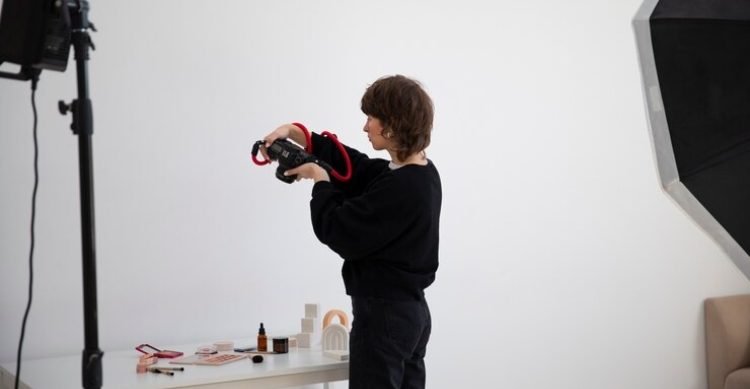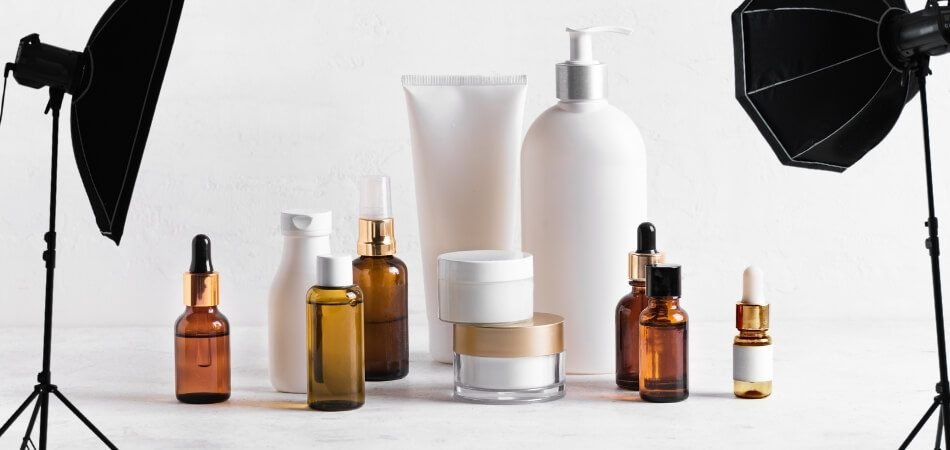The first step to improving photography is choosing a reliable camera, like a Canon DSLR. It’s not just about capturing images; it’s about telling a story that resonates with your audience.
Using the right tools is essential to bringing products to life for professional photographers. In this context, the question is, what do I need for product photography? can arise in many fans’ minds.
Rather than the camera, you’ll also need a sturdy tripod for stability, a white background for clarity, white bounce cards to reflect light, a table for setup, and tape to secure everything in place. Choosing a well-lit room with a window is also crucial for natural lighting.
Now that you have a glimpse into the essentials, dive deeper into this article to master the art of product photography.
Product Photography: What is it?
Product photography is all about capturing images of products in a way that showcases their features and appeal. It’s a crucial part of e-commerce and advertising because, let’s face it, we all like to see what we’re buying.
The goal is to make the product look as attractive as possible, highlighting its details and colors. This type of photography can range from simple shots on a white background to more creative setups that tell a story or evoke a mood.

Effective professional product photography for e-commerce business can make a substantial difference in how a product is perceived and can significantly impact sales. It’s not just about taking a picture; it’s about presenting the product in the best light possible, both literally and figuratively.
Next time you see a mouth-watering food advertisement or a stunning gadget online, remember that all of it is the result of product photography.
How Diverse is Product Photography?
There’s a wide variety of product photography! It’s a creative field that adapts to different products and marketing needs. Let’s explore some factors that contribute to this diversity.
Types of Products
The nature of the product greatly influences the photography style. For example, capturing the intricate details of jewelry requires a different approach than showcasing the sleek design of a smartphone.
Purpose of the Photography
The goal of the photography session also plays a role. Are the photos for an e-commerce website, a print catalog, or social media? Each platform may require a different style and focus.
Creative Styles
Photographers often experiment with various creative styles, such as lifestyle shots that show the product in use or minimalist shots that emphasize the product’s simplicity and elegance.
It is fair to say that product photography is a diverse field that offers ample room for creativity and innovation, catering to a wide variety of products and applications.
Can I Make Product Photography By Myself?
Yes, you can do product photography by yourself! With the right tools and some practice, you can create professional-looking photos that showcase your products effectively. Let’s break down some factors to consider.

Necessary Equipments
Invest in a good camera and a tripod for stable shots. Lighting is crucial, so consider using natural light or purchasing some basic lighting equipment. A white background helps to keep the focus on the product.
Learning the Basics
Familiarize yourself with basic photography principles, such as composition, framing, and exposure. There are plenty of online tutorials and courses available to help you get started.
Practice and Experimentation
Practice makes perfect! Experiment with different angles, lighting setups, and backgrounds to find what works best for your products. Don’t be afraid to try new things and learn from your mistakes.
What Do I Need for Product Photography?
Product photography is about showcasing your products in the most compelling way possible, literally! Whether you’re a small business owner or a budding photographer, knowing what you need for product photography is crucial. Hence the question, what do you need for product photography? arises.

Well, it’s not just about having a fancy camera. You’ll need a few essential tools and gadgets to get those crisp, clear, and captivating images that make your products stand out.
Let’s dive into the specifics.
A Well Defined Camera
A good camera is the cornerstone of product photography. You don’t necessarily need the most expensive model, but a camera with manual settings is a must. This allows you to control the aperture, shutter speed, and ISO, giving you the flexibility to adjust the exposure and depth of field to suit your product. You can also capture product photos with a phone, utilizing its increasingly sophisticated cameras and editing apps to achieve professional-looking results.
Tripod for Stability
A tripod is your best friend when it comes to stability. It eliminates camera shake, ensuring sharp images, especially in low-light conditions or when using slow shutter speeds. A tripod also allows you to maintain consistent framing and composition across multiple shots.
Lighting Systems
Lighting can make or break your product photos. Natural light is a great start, but for more control, consider investing in some artificial lighting. Softbox lights or LED panels can provide even, diffused light, reducing harsh shadows and highlighting the details of your product.
A Simple Background
A clean, uncluttered background keeps the focus on your product. A white backdrop is a popular choice as it reflects light well and makes it easier to cut out the product during post-processing. You can use a seamless paper roll, a white sheet, or a lightbox for smaller items.
Reflectors and Diffusers
Reflectors help bounce light back onto your product, filling in shadows and bringing out details. Diffusers, on the other hand, soften the light, creating a more even and flattering illumination. Both tools are essential for achieving professional-looking results.
Editing Software
Post-processing, a key stage in product photography, entails using editing software like Adobe Photoshop or Lightroom, often considered the best photo editing software for e-commerce, to fine-tune various aspects such as exposure, color balance, and sharpness. Additionally, these tools enable the removal of any blemishes or imperfections, ensuring the final images are of high quality and appeal.
By equipping yourself with these essential tools and taking the time to learn how to use them effectively, you’ll be well on your way to creating stunning product photos that captivate your audience and drive sales.
Self-Product Photography: How to Do It?
The experience of conducting a product photography session by oneself can be rewarding. It allows you to control the creative process, from setting up the shot to capturing the perfect image.

However, it requires some planning and preparation to ensure everything runs smoothly. Let’s walk through the steps to conduct a successful product photography session.
Step 1: Planning the Whole Project
Start by deciding on the look and feel you want for your photos. Consider the background, lighting, and any props you might need. Make a list of the products you’ll be photographing and plan out the shots you want to capture.
Step 2: Setup the Project Equipment
Set up your shooting area with your chosen background and arrange your lighting. Position your camera on a tripod to ensure stability and set it to the appropriate settings for your desired shot. Make sure your product is clean and positioned correctly.
Step 3: Shooting At Your Best
Take your time to capture each shot, adjusting the lighting and composition as needed. Experiment with different angles and perspectives to showcase your product in the best way possible. Check your images as you go to ensure they meet your standards.
However, if you find yourself overwhelmed with a bulk amount of product photography, consider seeking professional help. In that case, Visual Sparrow is a great option for those times when you need high-quality product photos but can’t handle the pressure of doing it all yourself. They can take the load off your shoulders and deliver stunning results.
FAQs About What Do I Need for Product Photography?
Product photography is a fascinating field that combines creativity with technical skills. If you’re interested in becoming a product photographer or enhancing your product photography, here are some frequently asked questions and their answers:
How Can I Become a Product Photographer?
To become a product photographer, a background in photography, advertising, or marketing is beneficial. To improve your skills, practice with different products and lighting setups. Build a portfolio of your work to attract clients.
Is Canva Good for Product Photography?
Canva can be a useful tool for product photography, especially for creating promotional materials. You can design your own promotions using your product photography.
How Do I Set Up Lighting for Product Photography?
Start with a main light source, such as a softbox, positioned at a 45-degree angle to the product. Use a reflector on the opposite side to fill in shadows. You can also add additional lights or diffusers to control the highlights and overall look of the image.
What Background Should I Use for Product Photography?
A plain white background is often preferred because it keeps the focus on the product and makes it easier to edit photos later. Colors and textures can also be experimented with, depending on your style.
What Are Some Tips for Taking Clear Product Photos?
Use a tripod to prevent camera shake and ensure sharp images. Set your camera to a low ISO to reduce noise. Use a small aperture (high f-number) to achieve a greater depth of field, keeping more of the product in focus.
Closing Remarks
To answer the question, “What do I need for product photography?” It’s essential to have the right equipment, including a camera with manual settings, a tripod, adequate lighting, and a clean background.
Planning and setting up your shooting area carefully will ensure that your products are showcased in the best light. To improve the process, practice with different lighting setups and angles, and edit your photos for a professional finish.
With the right tools and techniques, you can create stunning product photos that capture your audience’s attention.
